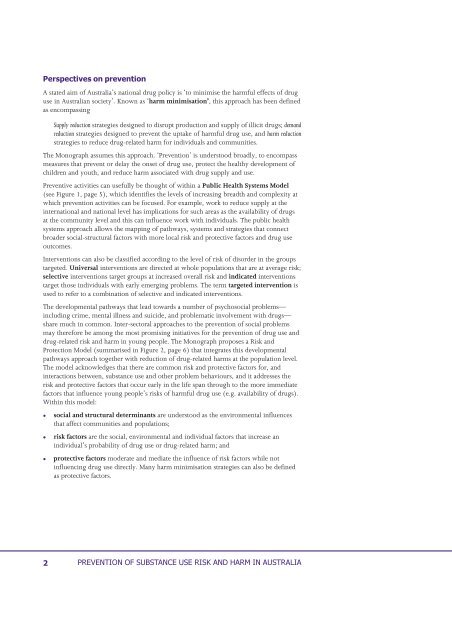Summary - Department of Health and Ageing
Summary - Department of Health and Ageing
Summary - Department of Health and Ageing
You also want an ePaper? Increase the reach of your titles
YUMPU automatically turns print PDFs into web optimized ePapers that Google loves.
A stated aim <strong>of</strong> Australia’s national drug policy is ‘to minimise the harmful effects <strong>of</strong> drug<br />
use in Australian society’. Known as ‘harm minimisation’, this approach has been defined<br />
as encompassing<br />
Supply reduction strategies designed to disrupt production <strong>and</strong> supply <strong>of</strong> illicit drugs; dem<strong>and</strong><br />
reduction strategies designed to prevent the uptake <strong>of</strong> harmful drug use, <strong>and</strong> harm reduction<br />
strategies to reduce drug-related harm for individuals <strong>and</strong> communities.<br />
The Monograph assumes this approach. ‘Prevention’ is understood broadly, to encompass<br />
measures that prevent or delay the onset <strong>of</strong> drug use, protect the healthy development <strong>of</strong><br />
children <strong>and</strong> youth, <strong>and</strong> reduce harm associated with drug supply <strong>and</strong> use.<br />
Preventive activities can usefully be thought <strong>of</strong> within a Public <strong>Health</strong> Systems Model<br />
(see Figure 1, page 5), which identifies the levels <strong>of</strong> increasing breadth <strong>and</strong> complexity at<br />
which prevention activities can be focused. For example, work to reduce supply at the<br />
international <strong>and</strong> national level has implications for such areas as the availability <strong>of</strong> drugs<br />
at the community level <strong>and</strong> this can influence work with individuals. The public health<br />
systems approach allows the mapping <strong>of</strong> pathways, systems <strong>and</strong> strategies that connect<br />
broader social-structural factors with more local risk <strong>and</strong> protective factors <strong>and</strong> drug use<br />
outcomes.<br />
Interventions can also be classified according to the level <strong>of</strong> risk <strong>of</strong> disorder in the groups<br />
targeted. Universal interventions are directed at whole populations that are at average risk;<br />
selective interventions target groups at increased overall risk <strong>and</strong> indicated interventions<br />
target those individuals with early emerging problems. The term targeted intervention is<br />
used to refer to a combination <strong>of</strong> selective <strong>and</strong> indicated interventions.<br />
The developmental pathways that lead towards a number <strong>of</strong> psychosocial problems—<br />
including crime, mental illness <strong>and</strong> suicide, <strong>and</strong> problematic involvement with drugs—<br />
share much in common. Inter-sectoral approaches to the prevention <strong>of</strong> social problems<br />
may therefore be among the most promising initiatives for the prevention <strong>of</strong> drug use <strong>and</strong><br />
drug-related risk <strong>and</strong> harm in young people. The Monograph proposes a Risk <strong>and</strong><br />
Protection Model (summarised in Figure 2, page 6) that integrates this developmental<br />
pathways approach together with reduction <strong>of</strong> drug-related harms at the population level.<br />
The model acknowledges that there are common risk <strong>and</strong> protective factors for, <strong>and</strong><br />
interactions between, substance use <strong>and</strong> other problem behaviours, <strong>and</strong> it addresses the<br />
risk <strong>and</strong> protective factors that occur early in the life span through to the more immediate<br />
factors that influence young people’s risks <strong>of</strong> harmful drug use (e.g. availability <strong>of</strong> drugs).<br />
Within this model:<br />
<br />
<br />
<br />
social <strong>and</strong> structural determinants are understood as the environmental influences<br />
that affect communities <strong>and</strong> populations;<br />
risk factors are the social, environmental <strong>and</strong> individual factors that increase an<br />
individual’s probability <strong>of</strong> drug use or drug-related harm; <strong>and</strong><br />
protective factors moderate <strong>and</strong> mediate the influence <strong>of</strong> risk factors while not<br />
influencing drug use directly. Many harm minimisation strategies can also be defined<br />
as protective factors.

















